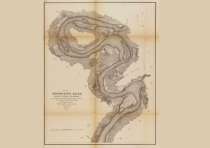
Fort Pickering was the strongest Union military installation on the Mississippi River as well as a safe haven for enslaved African American men and their families. Almost 1,200 black men enlisted in the Union Army at Fort Pickering.
In June 1861, Confederate supporters in Memphis erected earthworks to protect the city at Fort Pickering, the site of a frontier-era fortified trading post. Both slave and free black laborers built the stronghold, supervised by Capt. William Pickett and his company of sappers and miners. Local volunteers mounted artillery and built ammunition magazines on the two Indian mounds within the fort.
After the fall of Memphis in June 1862, the Union forces used Fort Pickering as a major supply depot and staging area. Gen. William T. Sherman increased the post’s size so that it extended for more than a mile along the river and a third of a mile inland. By 1864, with 102 cannons in place and more than 10,000 soldiers on duty, Fort Pickering was the strongest military installation on the Mississippi River.
As soon as Federal troops gained control of Memphis, hundreds of enslaved African Americans from Arkansas and Mississippi left their plantations to work for the army at Fort Pickering. The government established Camp Shiloh in 1862 and Camp Fiske in 1863 south of the fort to provide housing, churches, and schools for the families of the men who were employed there.
Many of the former field hands and laborers clamored to join the Union army. By December 1863, almost 1,200 African Americans had enlisted in the 3rd United States Colored Heavy Artillery Regiment. The black soldiers manned the huge guns that protected the river approaches to Memphis and performed guard detail and other duties. Col. Ignatz G. Kappner commanded the predominantly black garrison at Fort Pickering until the end of the war.
Tools
Key Facts
- Union forces used Fort Pickering as major supply depot and staging area
- Stongest military installation on the Mississippi River
- Became a predominantly African American garrison
- Two government established camps housed soldiers' families




